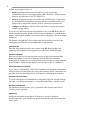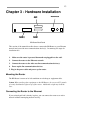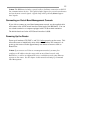
14
Connecting to Twisted-Pair Ethernet
Before connecting the router to twisted-pair cabling you need an unshielded twisted-
pair cable that is already connected to your 10BaseT-compatible twisted-pair hub.
To connect the router to the twisted-pair network, simply plug the twisted-pair cable
into the RJ-45 connector on the back of the unit.
Connecting a Line Device to the BR Router
The BR Router supports high-speed synchronous operation over a V.35 connector.
It also supports lower speed synchronous/asynchronous operation over an RS-232
connector.
The BR Router independently supports PPP and Frame Relay link protocols on each
WAN interface.
Connecting Devices to the V.35 Interface
This interface -- WAN 0 -- can be used to connect to a wide variety of line
communications devices, including those which support either leased or dialed
operation. Examples include leased 56K CSU/DSU’s, switched 56K CSU/DSU’s,
fractional T1 CSU/DSU’s, ISDN terminal adapters, and full T1/E1 rate
CSU/DSU’s.
You may select either dial-on-demand, redial if down (“always up” mode), or leased
line operation. This interface may also be set to receive ISDN or switched 56
incoming calls.
To connect a device, first make sure that both units are powered off. Then, simply
connect a V.35 cable (not supplied) between the router and the device.
Connecting Devices to the RS-232C Interface
This interface -- WAN 1 -- can be used to connect to synchronous or asynchronous
line communications devices at rates up to 256Kbps (sync), or (230.4 Kbps (async).
Examples include modems, leased or switched 56K CSU/DSU’s, and ISDN
terminal adapters.
You may select either dial-on-demand, redial if down (“always up” mode), or leased
line operation. This interface may also be set to receive ISDN or switched 56
incoming calls.
To connect a device, first make sure that both units are powered off. Then, simply
connect the supplied RS-232 cable between the router and the device.
v Note: The BR Router RS-232 interfaces require that your asynchronous line
communications device be set to supply the RS-232 DCD signal when a connection
has been made. A synchronous RS-232 device should be set to provide DSR.


















